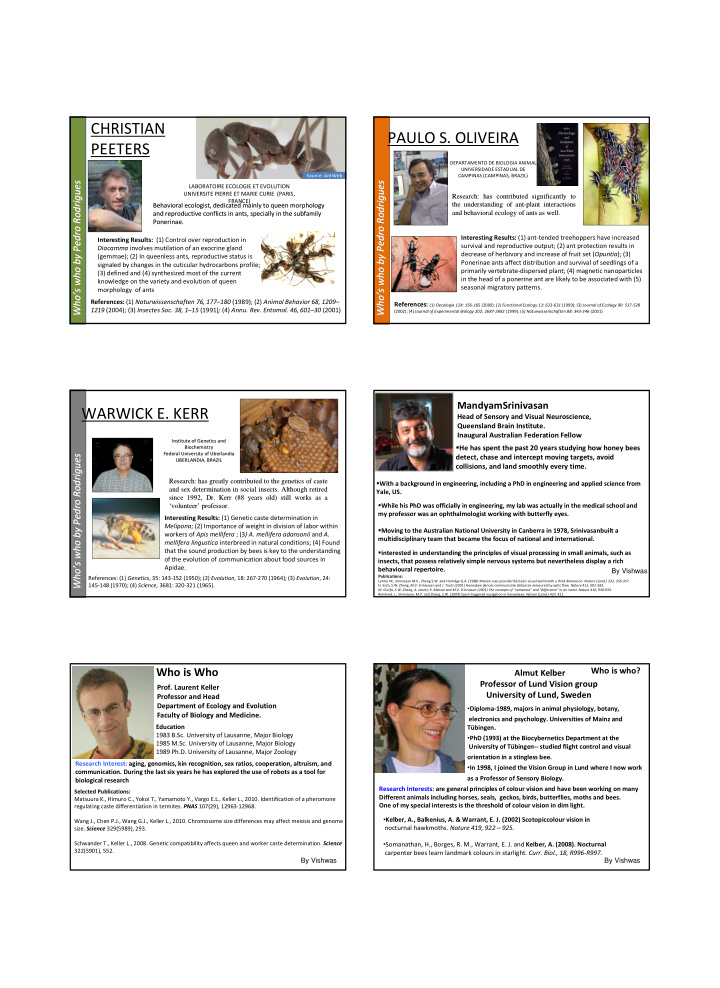



CHRISTIAN PAULO S. OLIVEIRA PEETERS DEPARTAMENTO DE BIOLOGIA ANIMAL UNIVERSIDADE ESTADUAL DE Source: AntWeb CAMPINAS (CAMPINAS, BRAZIL) s who by Pedro Rodrigues Rodrigues s who by Pedro Rodrigues Rodrigues LABORATOIRE ECOLOGIE ET EVOLUTION UNIVERSITE PIERRE ET MARIE CURIE (PARIS, Research: has contributed significantly to Research: has contributed significantly to FRANCE) the understanding of ant- the understanding of ant -plant interactions plant interactions Behavioral ecologist, dedicated mainly to queen morphology Behavioral ecologist, dedicated mainly to queen morphology and reproductive conflicts in ants, specially in the subfamily and reproductive conflicts in ants, specially in the subfamily and behavioral ecology of ants as well. and behavioral ecology of ants as well. Ponerinae. Ponerinae . ’s who by Pedro ’s who by Pedro Interesting Results: (1) ant-tended treehoppers have increased Interesting Results: (1) Control over reproduction in survival and reproductive output; (2) ant protection results in Diacamma involves mutilation of an exocrine gland decrease of herbivory and increase of fruit set ( Opuntia ); (3) (gemmae); (2) In queenless ants, reproductive status is Ponerinae ants affect distribution and survival of seedlings of a signaled by changes in the cuticular hydrocarbons profile; primarily vertebrate-dispersed plant; (4) magnetic nanoparticles (3) defined and (4) synthesized most of the current in the head of a ponerine ant are likely to be associated with (5) knowledge on the variety and evolution of queen seasonal migratory patterns. morphology of ants Who’ Who’ Who Who References: (1) Naturwissenschaften 76, 177–180 (1989); (2) Animal Behavior 68, 1209– References: (1) Oecologia 124: 156-165 (2000); (2) Functional Ecology 13: 623-631 (1999); (3) Journal of Ecology 90: 517-528 1219 (2004); (3) Insectes Soc. 38, 1–15 (1991) ; (4) Annu. Rev. Entomol. 46, 601–30 (2001) (2002); (4) Journal of Experimental Biology 202: 2687-2692 (1999); (5 ) Naturwissenschaften 88: 343-346 (2001) MandyamSrinivasan WARWICK E. KERR Head of Sensory and Visual Neuroscience, Queensland Brain Institute. Inaugural Australian Federation Fellow Institute of Genetics and Institute of Genetics and � He has spent the past 20 years studying how honey bees Biochemistry Biochemistry Federal University of Uberlandia Federal University of Uberlandia Rodrigues s who by Pedro Rodrigues detect, chase and intercept moving targets, avoid UBERLANDIA, BRAZIL UBERLANDIA, BRAZIL collisions, and land smoothly every time. Research: has greatly contributed to the genetics of caste Research: has greatly contributed to the genetics of caste � With a background in engineering, including a PhD in engineering and applied science from and sex determination in social insects. Although retired and sex determination in social insects. Although retired Yale, US. since 1992, Dr. Kerr (88 years old) still works as a since 1992, Dr. Kerr (88 years old) still works as a ’s who by Pedro � While his PhD was officially in engineering, my lab was actually in the medical school and ‘volunteer ‘ volunteer’ ’ professor. professor. my professor was an ophthalmologist working with butterfly eyes. Interesting Results: (1) Genetic caste determination in Melipona ; (2) Importance of weight in division of labor within � Moving to the Australian National University in Canberra in 1978, Srinivasanbuilt a workers of Apis mellifera ; (3 ) A. mellifera adansonii and A. multidisciplinary team that became the focus of national and international. mellifera lingustica interbreed in natural conditions; (4) Found that the sound production by bees is key to the understanding � interested in understanding the principles of visual processing in small animals, such as of the evolution of communication about food sources in insects, that possess relatively simple nervous systems but nevertheless display a rich Apidae. Who’ behavioural repertoire. By Vishwas Who Publications: References: (1) Genetics , 35: 143-152 (1950); (2) Evolution , 18: 267-270 (1964); (3) Evolution , 24: Lehrer M., Srinivasan M.V., Zhang S.W. and Horridge G.A. (1988) Motion cues provide the bee's visual world with a third dimension. Nature (Lond.) 332, 356-357. 145-148 (1970); (4) Science, 3681: 320-321 (1965). H. Esch, S.W. Zhang, M.V. Srinivasan and J. Tautz (2001) Honeybee dances communicate distances measured by optic flow. Nature 411, 581-583. M. Giurfa, S.W. Zhang, A. Jenett, R. Menzel and M.V. Srinivasan (2001) The concepts of “sameness” and “difference” in an insect. Nature 410, 930-933. Reinhard, J., Srinivasan, M.V. and Zhang, S.W. (2004) Scent-triggered navigation in honeybees. Nature (Lond.) 427, 411. Who is Who Who is who? Almut Kelber Professor of Lund Vision group Prof. Laurent Keller University of Lund, Sweden Professor and Head Department of Ecology and Evolution • Diploma-1989, majors in animal physiology, botany, Faculty of Biology and Medicine. electronics and psychology. Universities of Mainz and Education Tübingen. 1983 B.Sc. University of Lausanne, Major Biology • PhD (1993) at the Biocybernetics Department at the 1985 M.Sc. University of Lausanne, Major Biology University of Tübingen-- studied flight control and visual 1989 Ph.D. University of Lausanne, Major Zoology orientation in a stingless bee. Research Interest: aging, genomics, kin recognition, sex ratios, cooperation, altruism, and • In 1998, I joined the Vision Group in Lund where I now work communication. During the last six years he has explored the use of robots as a tool for as a Professor of Sensory Biology. biological research Research Interests: are general principles of colour vision and have been working on many Selected Publications: Different animals including horses, seals, geckos, birds, butterflies, moths and bees. Matsuura K., Himuro C., Yokoi T., Yamamoto Y., Vargo E.L., Keller L., 2010. Identification of a pheromone One of my special interests is the threshold of colour vision in dim light. regulating caste differentiation in termites. PNAS 107(29), 12963-12968. • Kelber, A., Balkenius, A. & Warrant, E. J. (2002) Scotopiccolour vision in Wang J., Chen P.J., Wang G.J., Keller L., 2010. Chromosome size differences may affect meiosis and genome nocturnal hawkmoths. Nature 419, 922 – 925. size. Science 329(5989), 293. Schwander T., Keller L., 2008. Genetic compatibility affects queen and worker caste determination. Science • Somanathan, H., Borges, R. M., Warrant, E. J. and Kelber, A. (2008). Nocturnal 322(5901), 552. carpenter bees learn landmark colours in starlight. Curr. Biol., 18, R996-R997. By Vishwas By Vishwas
Recommend
More recommend